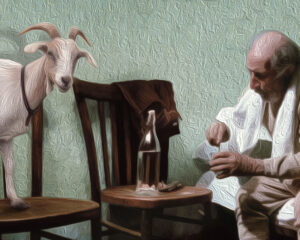
In Le Quattro Volte (The Four Times) (2010), an old man dies and his lamb is left to die alone under a tree. The tree is then cut down as a prop for a festival. Finally, the wood is burnt to make charcoal which is then distributed to many households in the village the film is set in. There is no traditional plot, only the cycles of these four forms of life.
Most of the long-takes in Le Quattro Volte consist of both medium and long distance shots. These long distance shots give a sense of detachment but some convey an attitude of curiosity and concern as the camera pans. The close-ups, on the other hand, are much more serious and mostly consist of fixed scenes and fixed angular positions. This gives the impression of an old man, repeating himself day after day and the general monotony of the world. The two different styles of shot are interspersed throughout the film. One moment a distant shot of sheep scattered around. The next, the old man lying on his bed. One moment the lamb is shown looking upwards, the next we see the sky scattered with clouds. This gives us a sense of transcendence over individual things and dissipates the sadness of the impermanence of life. It also focusses the film on the old man, the lamb, the tree and the charcoal as they change over time. The film is interested in their transformation.
Another admirable quality of the film’s style, is the way the camera ‘disappears’ when switching between long shots. The film’s greatest feeling is one of pure observation where there is no separation between the observer and the observed, only the viewer’s primal glimpse of life. When we are confronted with the death of the old man in front of the camera, his death does not provoke sadness in us. Our real-life emotional experiences no longer apply here. The subject disappears and the object remains.
To borrow a line from Rilke’s poem: ‘When the gaze of some animal, silent, calm, penetrates us completely. This is what fate means: to face each other, always to face each other, and nothing else. Where we see the future, it sees all time, it is itself in all time.’ This is how director Michelangelo Frammartino’s long-shots make me feel. When the camera adopts a ‘non-human’ point of view, the camera disappears and there is only the absolute clarity of observation.
Written for The Film Dispatch by Kanghui Gao.

